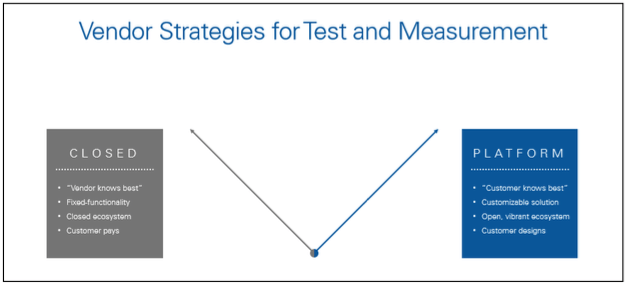As an increasing number of design teams and firms set their crosshair on developing systems for the Internet of Things paradigm, they face the challenge of developing for more complex wireless technologies. Could tools like the vector signal transceiver help here?
If we were to look at the common Wi-Fi itself, successive standards have taken this standard from ‘a + b +g’, to ‘n’ and now to ‘ac’. Increasing number of channels, operation modes, and more spatial streams contribute to higher complexity for these devices. Firms have no other go but to grow up to the challenge.
Rising up to the challenge
Qualcomm is one example, which has been able to use the vector signal transceiver (VST) and its digital interface of the device simultaneously with the RF signal generator and analyser to improve their product.
Previous rack and stand systems, even when automated, resulted in very low test times for Qualcomm while being only able to characterise 30-40 channels every time. This meant that their teams would have to iterate their test, and do so through many weeks, to get the information that they needed. The vector signal transceiver allowed Qualcomm to characterise the entire game table sweep in one insertion.
For firms running on older systems the backplane was one of the bottlenecks. Moving to vector signal transceiver resolved this issue because of its PXI backplane. PXI has grown by a CAGR of more than 15% for the past 5 years and Frost and Sullivan estimates that it will continue on this trajectory. Software was the key to this growth.
“NI’s approach embraces a “customer knows best” rather than a “vendor knows best” approach. So as the devices around us become increasingly smarter, customers have two choices: wait for their vendor to deliver a temporary solution that cannot be modified, or take a smarter option. A platform-based approach of modular hardware and open, flexible software that is supported by an ever expanding ecosystem lets them customize their solution,” explains Rahman Jamal, Global Technology & Marketing Director at National Instruments.
What’s new in vector signal transceiver?
On July 12th, NI accounced the world’s first 1 GHz bandwidth VST that combines a 6.5 GHz RF vector signal generator, 6.5 GHz vector signal analyzer, high-performance user-programmable FPGA and high-speed serial and parallel digital interfaces into a single 2-slot PXI Express module. With 1 GHz of bandwidth, the latest VST is ideally suited for a wide range of applications including 802.11ac/ax device testing, mobile/Internet of Things device testing, 5G design and testing, RFIC testing, radar prototyping and more.
What does the latest VST feature?
- 1 GHz of instantaneous bandwidth for advanced digital pre-distortion (DPD) test and wideband signals such as radar, LTE-Advanced Pro and 5G
- Excellent measurement accuracy that enables the second-generation VST to measure 802.11ax Error Vector Magnitude (EVM) performance of -50 dB
- Measurement speeds up to 10X faster than traditional instrumentation using FPGA-based measurement acceleration and highly optimized measurement software
- Small size and tight synchronization allowing for up to 8×8 multiple input, multiple output (MIMO) configuration in a single 18-slot chassis
- User-programmable FPGA that engineers can easily design with LabVIEW






